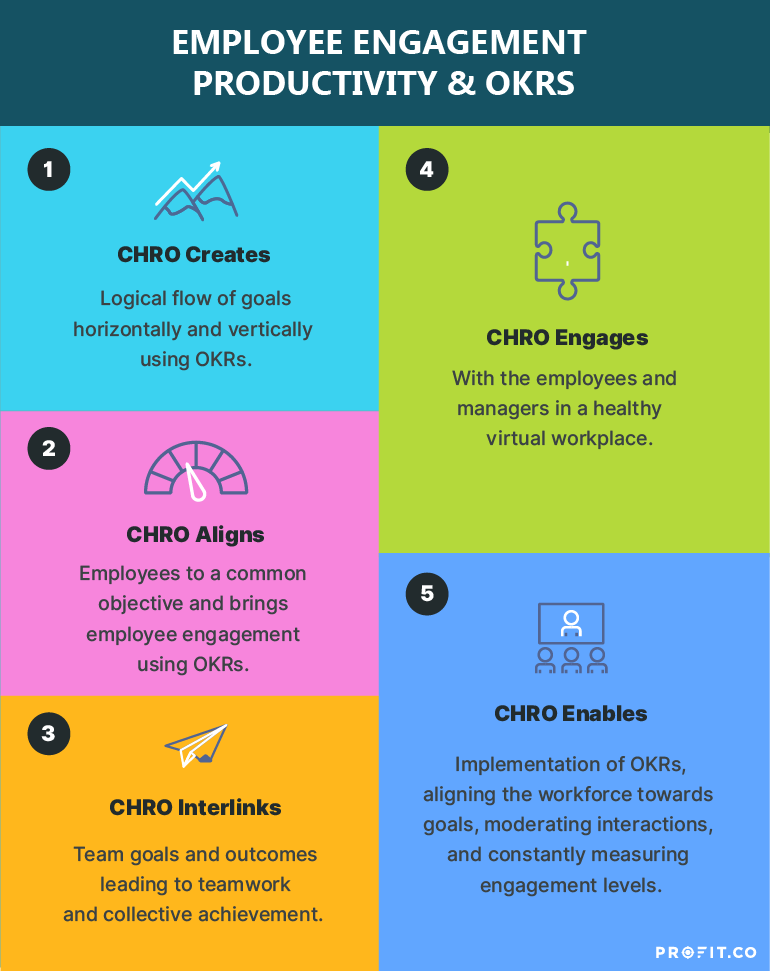The role of CHRO changed irreversibly in 2020 and 21. During the pandemic, the CHROs had new challenges in addition to their regular responsibilities. Nothing prepared them to face layoffs, mental health, remote work, and new approaches of handling remote work to ensure efficiency.
Let’s look at the top 5 challenges the CHROs face:
1. Make remote work, work
2. Assuage employee distress during this time of uncertainty
3. Diversity and inclusion issues
4. Keeping employee engagement and productivity levels high
5. Reskilling and upskilling employees and HR systems

Let us look closer: What are the challenges for CHRO?
CHRO Challenge 1: Make remote work, work
The years of the global pandemic, 2020 and 2021, heralded a new normal, something that we never thought was possible. Remote work is here to stay, whether fully remote or hybrid. Companies are investing in and adopting technologies that enable employees to work and collaborate remotely, but challenges remain. CHROs need to be on their toes as they keep updating remote working policies and ensure the workforce remains connected remotely, as they plan for the new normal of work, in whatever form.
How does OKR help CHROs manage remote work?
CHROs leverage the power of objectives and key results to manage the complexities of hybrid and remote work setups.
1. OKR places responsibility on the self to set goals and achieve them; it removes managerial control and empowers employees to work independently.
2. OKR implementation promotes self-motivation and achievement in remote work setup.
3. The CHRO constantly updates remote work policies and aligns the workforce through the HR OKRs, implementing them effectively and bringing everyone into synchronization quickly.
4. OKR demands collaboration and teamwork to get work done from a remote location. It brings the team closer, making the work of HR teams easy.
5. When employees are affected by the change in a work environment, the CHRO acts as a moderator and enabler who motivates employees to achieve their OKRs.
6. Cloud-based OKR systems enable employees to set goals, update progress, and review completed goals remotely through a browser.
7. With these advantages inherent to OKR framework, CHROs quickly re-establish the connections, facilitate communications and virtualize the work environment.
A CHRO OKR Example
Objective: Establish guidelines for hybrid work setup.
Key Results:
- Conduct a survey covering every employee on where they want to work from in the next quarter.
- Achieve 40% attendance at the workplace at any given time within a month.
- Ensure that at least 90% of employees have worked from the office at least one week per month.
- Identify the tools for online meetings and collaboration, and standardize them for 100% of the workforce within a month.
- Determine the right time of weekly meetings to include people from different time zones and achieve an average of 95% online meeting attendance within a month.
CHRO Challenge 2: Assuage employee distress during this time of uncertainty
With the global pandemic came an economic downturn, social unrest, and a rise in mental health crises. The HR leadership had to reshape policies and functions. Pandemic-related job losses, inability to interact in a social setup, being confined in a socially-isolating work mode, and lack of job security are slowly affecting mental health.
To put an end to this distress during this moment of uncertainty, the CHRO and their team must take active steps to keep their employees engaged and foster social interaction, provide mental health support and benefits and be honest and transparent about the company policies.
OKRs and resilience
To stay connected and revive the synergy the teams had at the workplace previously, CHROs should ensure resilience in OKRs. This helps CHROs to build a healthy and happy workforce and enable them to perform at the highest levels, even remotely.
1. Resilience OKRs bring physical and mental health and wellbeing into the purview of OKR goals.
2. Health and wellbeing become part of the work-related priorities.
3. Resilience goals are constantly reviewed and supported by the team and the leaders in the same way as the work-related goals.
4. Everyone gets support from the team and vice versa to achieve their resilience goals.
5. This results in good physical and mental health, trust, better working relationship, understanding, and collaboration amongst team members.
A CHRO OKR Example for building a happy team
Objective: Build a healthy and happy team.
Key Results:
- Spend the first 10 minutes of every meeting enquiring about physical and mental health.
- Arrange for at least one informal session for friendly conversations within the team at least once in 10 days.
- Devise a resilience metric to give a health and happiness score for every employee twice a month.
- Arrange for an accessible online psychiatric counselor. Ensure that every employee gets a counseling session at least once a month.
- Every quarter, align every member to overall resilience goals and ensure they achieve more than 80% in resilience score by the end of the quarter.
It’s not a faith in technology. It’s faith in people.
CHRO Challenge 3: Diversity and inclusion issues
In the wake of a specific unfavorable cultural climate, especially amid the pandemic that has been increasingly impacting people of color, the C-suite has been asked to respond on matters of social justice. Those events have been a catalyst for a more inclusive, integrated, and strategic approach, especially towards minorities and women, who have been known to be hit disproportionately by the pandemic.
While evaluating talent, tech-powered solutions with a human-centric approach should ensure there are no biases. Automated skills assessment testing platforms identify qualified talent based on verified skill sets and traits that determine success in those roles so that HR personnel can make unbiased hiring decisions.
Work towards ambitious OKRs for addressing diversity and inclusion issues
Since OKR aims at over-achievement through ambitious and aggressive goal setting, the CHROs can address diversity and inclusion issues during the pandemic using OKR.
1. CHROs set dedicated diversity and inclusion OKRs for the HR team.
2. Diversity and inclusion OKRs aim at generating opportunities, hiring, inclusiveness, skill development, career development, accessibility to senior leadership, safety, and fair reviews.
3. These OKRs ensure diversity at all levels of the organization, including the leadership.
4. These OKRs benefit women, people of color, minorities, differently-abled, etc., in the workforce.
5. OKR achieves quick alignment across teams and organizations, and these diversity and inclusion OKRs create a workplace of diversity and equal opportunities.
A CHRO OKR Example for increasing diversity
Objective: Increase diversity up to 30% within two years.
Key Results:
- Define and finalize what diversity is part of the organizational culture in the next two meetings with the management.
- Create quotas within the diverse 30% for various shortlisted, under-represented groups in a month.
- Recruit and fill at least 4% out of the 30% quota in the first quarter.
- Identify a diverse talent pool within the organization and ensure 50% of them are upskilled for promotion by the end of the year.
- Ensure 10% of the leadership has diversity as per the quota by the end of the year.
CHRO Challenge 4: Keeping employee engagement and productivity levels high
Keeping employee engagement and productivity levels high in the newly changed workplace environment is yet another challenge that CHROs face. As employees sit at their desks for long periods, without the natural breaks and informal ‘water-cooler chats’, work fatigue is bound to creep in. New cultural divides appear– employees that can work from home versus frontline employees who don’t have that option or those that can afford home offices versus those at kitchen tables.
CHROs need to be on top of, and also anticipate all these changes that are happening and might happen. They need to ensure that the employees who need more interaction with their managers, whether to share information or just to reduce anxiety, CHROs should be able to facilitate that. It should be on their agenda to contain any productivity losses, energize the workforce, and drive performance.
Engaged and Interlinked by goal alignment
Creating employment engagement is one of the priorities of CHRO, as it is crucial for employee retention and satisfaction at work. While it can be challenging in a hybrid work setup or a remote work model, CHROs can keep the workforce engaged through OKRs.
1. CHROs create a logical flow of goals from top to bottom, and later horizontally, using OKR.
2. OKR aligns employees to a common objective. Working towards common goals brings employee engagement.
3. Team goals and outcomes are interlinked and shared amongst the team members, leading to teamwork, engagement, and collective achievement.
4. Employees constantly interact with peers and managers to set goals in line with team OKRs, work together, review their team outcomes and collectively celebrate the little successes. This creates a healthy virtual workplace, where employees are aligned and engaged.
5. CHRO always remains an enabler in implementing OKRs, aligning the workforce towards goals, moderating interactions, and constantly measuring engagement levels.
A CHRO OKR Example for increased employee engagement
Objective: Create a harmonious, engaged workforce by the end of this quarter.
Key Results:
- Allot 10 minutes of weekly team meetings to listen to how employees interpret organization goals and how their individual goals help the organization.
- Organize at least one get together per month to celebrate individual and collective achievements
- Moderate multi-location, multicultural summit every month, where team members from around the world get to know everyone, share their experiences, inspire others, and get inspired by others’ work
- Identify team enablers in every team once in a month and give them the role of moderating team discussions on a rotational basis to build synergy within teams
- Organize informal meet-ups of team members in public spaces away from work every month to bring together various team members
Want to get started on an intuitive and agile performance management software today? Start your free trial of Profit.co!

CHRO Challenge 5: Reskilling and upskilling employees and HR systems
With the change in the work environment, it goes without saying that there will be changes in the manner of work that will be expected of employees. The employees, as well as HR, will need to learn new skills. The CHRO needs to up the ante on their training and development capabilities. The CHRO needs to address weaknesses in HR processes and elsewhere that the organization is lacking
Set up learning goals suitable for better adaptability
CHRO is the ultimate authority for identifying re-skilling and upscaling needs amongst the workforce. OKR helps to understand where the workforce lacks and how it can be rectified.
1. CHROs identify the training and skill development needs from weekly reviews when specific teams or employees cannot achieve their OKRs or overcome challenges in a remote work setup.
2. The CHRO arranges suitable training programs for upskilling and reskilling.
3. The CHRO sets OKR goals for training and skill development, pushing the teams and individuals to work hard, learn and gain crucial skills before your organization loses its competitive edge.
A CHRO OKR Example for optimizing training and development
Objective: Optimize HR processes and create an up-to-date workforce with training and skill development initiatives.
Key Results:
- Benchmark HR processes and assess the weaknesses with the help of an expert group within a month.
- Organize a training workshop for the HR team during the second month of the quarter to upgrade HR processes in line with the benchmarks and address the weaknesses.
- Conduct a skills audit amongst the workforce as part of weekly meetings and shortlist training requirements within a month.
- Identify suitable training programs to upskill and res-skill the employees in the second month of the quarter.
- Organize training programs and ensure that at least 20% of the identified employees who need to upgrade skills complete suitable training by the end of the quarter.
OKRs are a tool to face the challenges faced in a dynamic work environment riddled with uncertainty:
CHRO faces a number of challenges to ensure that their business runs smoothly and maximizes performance. Planning to combat these issues is the best way to address these challenges. With the right plans and tools like OKRs, CHROs can easily meet many of today’s challenges.
Book a free demo with our team to learn more about Profit.co’s OKR platform to power your teams to productivity with integration and visibility.

